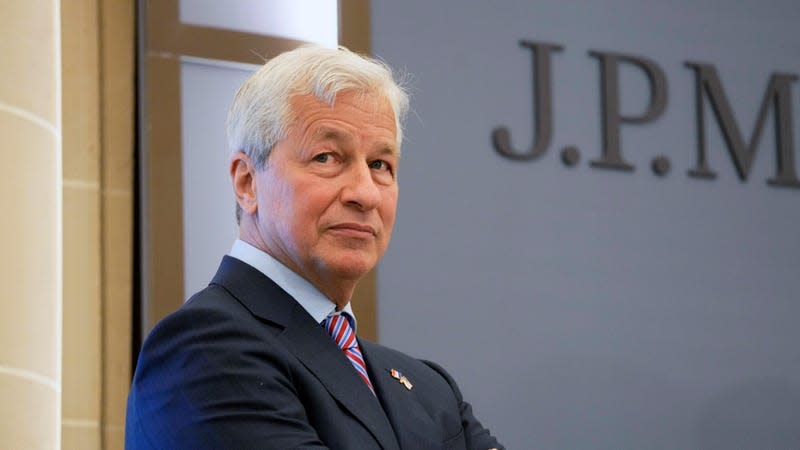
Jamie Dimon, banking’s savior?
You can ask why JPMorgan Chase agreed to buy the failed First Republic Bank out of regulatory receivership. But a better question might be, why not? As JPMorgan chairman and CEO Jamie Dimon explained in a company press release: “This acquisition modestly benefits our company overall, it is accretive to shareholders, it helps further advance our wealth strategy, and it is complementary to our existing franchise.”
In other words, no big deal. And it really isn’t a big deal compared to JPMorgan’s $3.7 trillion in assets at the end of March, which will now grow by roughly $200 billion thanks to the purchase of First Republic.
Read more
Whole Foods has shut down a store in downtown San Francisco on safety concerns
Your anxiety brings 4 distinct superpowers
Americans may have seen the last of big rent hikes
Of course, to anyone worried about the implications of too-big-to-fail institutions getting bigger, this acquisition adds roughly $200 billion of ballast to the argument.
Why did the FDIC choose JPMorgan Chase’s bid for First Republic?
It’s not often that CEOs enter high-profile bidding contests for things they expect to just “modestly benefit” their companies. But it’s also not often that a $3.7 trillion-asset bank gets instantaneous regulatory approval to gobble up substantially all the assets of a $229.1 billion-asset bank, plus $104 billion in deposits, overnight.
The FDIC says the resolution of First Republic “involved a highly competitive bidding process and resulted in a transaction consistent with the least-cost requirements of the Federal Deposit Insurance Act.” As part of the deal, the FDIC and JPMorgan will share in the losses, but also in any potential recoveries, on residential and commercial loans made by First Republic. JPMorgan Chase will not be assuming First Republic’s corporate debt or preferred stock as part of the deal.
All 84 First Republic offices in eight US states will reopen today (May 1) as branches of JPMorgan Chase, and customers of the former First Republic will have “full access to all of their deposits,” the FDIC said.
Story continues
All told, the FDIC estimates that the receivership of First Republic will cost its Deposit Insurance Fund, which is financed mainly by assessments on US banks, about $13 billion.
“Our government invited us and others to step up, and we did,” Dimon said in JPMorgan Chase’s statement about the deal. “Our financial strength, capabilities and business model allowed us to develop a bid to execute the transaction in a way to minimize costs to the Deposit Insurance Fund.”
Memories of Bear Stearns, WaMu
Dimon worked closely with US Treasury secretary Janet Yellen in March to drum up a combined $30 billion deposited into First Republic by 11 big US banks.
The rescue attempt failed. On April 24, First Republic disclosed that customers had yanked more than $100 billion in deposits from the bank in the first quarter, triggering another crash in First Republic shares and ultimately landing the bank in receivership. And Dimon once again was there to assist.
A full-blown acquisition of a bank is far riskier than a deposit infusion. Dimon, of all people, knows this. Over the years, he has made no secret of his regrets over buying Bear Stearns and Washington Mutual in 2008. While those acquisitions burnished his role as the white knight of banking, riding to the rescue of troubled institutions that otherwise posed risks to the broader financial system, they also opened his company to billions of dollars in unforeseen legal costs. As Dimon wrote in 2015 in a letter to shareholders (pdf):
No, we would not do something like Bear Stearns again—in fact, I don’t think our Board would let me take the call. The WaMu deal might still make sense but at a much lower price to make up for the ongoing legal uncertainty (including the government’s ability to take away our bargained-for indemnities). I did not, and perhaps could not, have anticipated such a turn of events. These are expensive lessons that I will not forget.
JPMorgan Chase shareholders are trusting that’s the case. And there is reason for them to be optimistic. Though caught up in a panic that seems contained to banks with unusually heavy amounts of uninsured deposits and balance sheets overburdened with interest rate risks, First Republic was in far better shape than most banks were in 2008, when many institutions were concentrated in toxic assets with low chances of recovery and high amounts of legal risk.
JPMorgan shares are responding positively to the First Republic news
JPMorgan Chase says it will take a $2.6 billion one-time gain tied to the transaction, but also $2 billion in related restructuring costs spread across 2023 and 2024. Excluding those items, the acquisition is expected to add more than $500 million a year to JPMorgan’s net income.
In a sign of investor confidence in the move, JPMorgan shares, which closed Friday at $138.24, were up more than 4% in pre-market trading on Monday.
More from Quartz
The world’s biggest banknote printer said the demand for cash hit a two-decade low
What were the world’s busiest airports in 2022?
Sign up for Quartz’s Newsletter. For the latest news, Facebook, Twitter and Instagram.
Click here to read the full article.